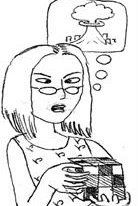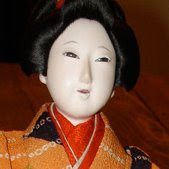
I recently bought a book called "Japanese Dolls: the Fascinating World of Ningyo" by Alan Scott Pate (http://www.antiquejapanesedolls.com/). Mr. Pate's other book, Ningyo: The Art of the Japanese Doll is mainly on the styles of dolls that you seen in museums and the kind that aren't allowed to leave Japan. The kind that live in temperature controlled rooms carefully monitored by their obsessive-compulsive rich owners.
Fascinating World of Ningyo is more about collecting Japanese Dolls, and features more like the very upper end of what you might find on Ebay on a really good week. This book is invaluable for any non-japanophone who is looking to collect Japanese Dolls....
Forget I said that. Buy the shiny ones! Yeah! The ones with the finely rendered faces and hands that aren't made of plastic? Those are not the dolls you are looking for.
What? My Jedi Mind Tricks do not work on you? Fine. But if you ever outbid me on anything, I'll send you a bloody virus!
While looking through this book, I found a doll label that looked oddly familiar. Remember when I was trying to decide if my little "bijin" (beautiful woman) doll was a Maruhei doll? I mean, the label was similar, but some parts just didn't match up?
 With the help of Kimiko, I'd decided that the doll was made by a company called the Ooki doll company. The label in the book was captioned "Ookiheizo(Maruhei) in Kyoto, Ca. 1900."
With the help of Kimiko, I'd decided that the doll was made by a company called the Ooki doll company. The label in the book was captioned "Ookiheizo(Maruhei) in Kyoto, Ca. 1900."If you'll remember from the previous article, Ookiheizo (or, to us yanks, Heizo Ooki) was the name that the master dollmaker and store-owner and his successors took.
So, this Ooki Doll Company was, after all, Maruhei.

The label stamped on the bottom of my doll reads: (Thanks to Kimiko for the translation!)
TOP ROW: (Item in circle is the store logo), From right to left around it, it says "KYOTO"
LEFTMOST COLUMN : Phone number
SECOND FROM LEFT COLUMN: Ooki company, or Ookiheizo
MIDDLE COLUMN: Hina Ningyo
RIGHT COLUMN: Northeast Corner, Sakai St. Sijyo.
To top it all off, I found a website about Maruhei dolls. Not sure it's the official store site, but it provides a list of labels since the mid 1800's. (Maruhei still makes dolls)
My label is the stamped one about halfway down. Babelfish says it's from the late Meiji Period to the Early Showa period, so I was about right in my dating.


No comments:
Post a Comment